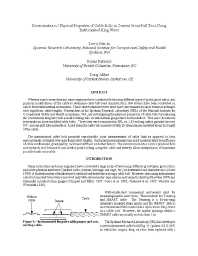Mining Publication: Determination of Physical Properties of Cable Bolts in Cement Grout Pull Tests Using Instrumented King Wires
Original creation date: April 2000
Whereas many researchers and mine engineers have conducted tests using different types of grout, grout ratios, and physical modifications of the cable to determine cable bolt load characteristics, few studies have been conducted on cables fitted with internal instruments. Those studies that have been done have concentrated on cable behavior averaged over significant cable lengths. Researchers at the Spokane Research Laboratory (SRL) of the National Institute for Occupational Safety and Health in Spokane, WA, are investigating the physical properties of cable bolts by replacing the conventional king wire with a modified king wire on which strain gauges have been installed. This paper documents test results on these modified cable bolts. Three tests were conducted at SRL on 1.83-m-long cables grouted into two 0.91-m-long pull-tube assemblies. Load along the cable was monitored with 20 strain gauges installed along the length of the cable. The instrumented cable bolt provided reproducible point measurements of cable load as opposed to load measurements averaged over significant cable lengths. Such point measurements can assist in interpreting the influence of cable confinement, grout quality, rock mass stiffness, and other factors. The instrumented cable bolt is a practical field and research tool because it can predict point loading along the cable and thereby allow interpolation of maximum possible loads on a cable.
Authors: LA Martin, R Pakalnis, D Milne
Conference Paper - April 2000
Canadian Institute of Mining Annual Conference, Vancouver, BC, 2002 Apr; 8 pp
See Also
- Development and Application of the Coal Mine Roof Rating (CMRR)
- Diagnosing and Controlling Moisture-Sensitive Roof in Coal Mines
- Mistakes, Misconceptions, and Key Points Regarding Secondary Roof Support Systems
- Optimizing Secondary Roof Support with the NIOSH Support Technology Optimization Program (STOP)
- Overview of Coal Mine Ground Control Issues in the Illinois Basin
- Performance Characteristics for Welded Wire Screen Used for Surface Control in Underground Coal Mines
- Preventing Falls of Ground in Coal Mines With Exceptionally Low-Strength Roof: Two Case Studies
- Preventing Injuries Caused by Unrecognized Stone Mine Roof Beam Failures With a Pro-Active Roof Control Plan
- Technology News 476 - Instrumented King Wire for Monitoring Cable Bolts
- Updating the NIOSH Support Technology Optimization Program (STOP) With New Support Technologies and Additional Design Features
- Page last reviewed: 9/21/2012
- Page last updated: 9/21/2012
- Content source: National Institute for Occupational Safety and Health, Mining Program


 ShareCompartir
ShareCompartir
